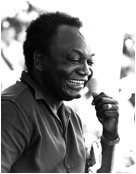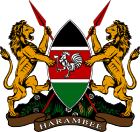
A part of Eastern Africa, the territory of what is known as Kenya has seen human habitation since the beginning of the Lower Paleolithic. The Bantu expansion from a West African centre of dispersal reached the area by the 1st millennium AD. With the borders of the modern state at the crossroads of the Bantu, Nilo-Saharan and Afro-Asiatic ethno-linguistic areas of Africa, Kenya is a multi-ethnic state. The Wanga Kingdom was formally established in the late 17th century. The Kingdom covered from the Jinja in Uganda to Naivasha in the East of Kenya. This is the first time the Wanga people and Luhya tribe were united and led by a centralized leader, a king, known as the Nabongo.

Daniel Toroitich arap Moi was a Kenyan politician who served as the second president of Kenya from 1978 to 2002. He is the country's longest-serving president to date. Moi previously served as the third vice president of Kenya from 1967 to 1978 under President Jomo Kenyatta, becoming the president following the latter's death.

The Kenya African National Union (KANU) is a Kenyan political party that ruled for nearly 40 years after Kenya's independence from British colonial rule in 1963 until its electoral loss in 2002. It was known as Kenya African Union (KAU) from 1944 but due to pressure from the colonial government, KAU changed its name to Kenya African Study Union (KASU) mainly because all political parties were banned in 1939 following the start of the Second World War. In 1946 KASU rebranded itself into KAU following the resignation of Harry Thuku as president due to internal differences between the moderates who wanted peaceful negotiations and the militants who wanted to use force, the latter forming the Aanake a forty, which later became the Mau Mau. His post was then occupied by James Gichuru, who stepped down for Jomo Kenyatta in 1947 as president of KAU. The KAU was banned by the colonial government from 1952 to 1960. It was re-established by James Gichuru in 1960 and renamed KANU on 14 May 1960 after a merger with Tom Mboya's Kenya Independence Movement.

The Kenya African Democratic Union (KADU) was a political party in Kenya. It was founded in 1960 when several leading politicians refused to join Jomo Kenyatta's Kenya African National Union (KANU). It was led by Ronald Ngala who was joined by Moi's Kalenjin Political Alliance, the Masai United Front, the Kenya African Peoples Party, the Coast African Political Union, Masinde Muliro's Baluhya Political Union and the Somali National Front. The separate tribal organisations were to retain their identity and so, from the very start, KADU based its political approach on tribalism. KADU's aim was to defend the interests of the so-called KAMATUSA as well as the British settlers, against the imagined future dominance of the larger Luo and Kikuyu that comprised the majority of KANU's membership, when it became inevitable that Kenya will achieve its independence. The KADU objective was to work towards a multiracial self government within the existing colonial political system. After release of Jomo Kenyatta, KADU was becoming increasingly popular with European settlers and, on the whole, repudiated Kenyatta's leadership. KADU's plan at Lancaster meetings was devised by European supporters, essentially to protect prevailing British settlers land rights.

Elections in Kenya take place within the framework of a multi-party democracy and a presidential system. The President, Senate and National Assembly are directly elected by voters, with elections organised by the Independent Electoral and Boundaries Commission (IEBC).
Henry Pius Masinde Muliro was a Kenyan politician from the Bukusu sub-tribe of the larger Abaluhya people of western Kenya. He was one of the central figures in the shaping of the political landscape in Kenya. An anti-colonial activist, he campaigned for the restoration of multi-party democracy in Kenya in his later years.
The Orange Democratic Movement (ODM) is a centre-left political party in Kenya. It is the successor of a grassroots people's movement that was formed during the 2005 Kenyan constitutional referendum campaign. This movement separated in August 2007 into the Orange Democratic Movement Party of Kenya and the Wiper Democratic Movement – Kenya.

General elections were held in Kenya on 27 December 2002. Voters elected the President, and members of the National Assembly. They coincided with the 2002 Kenyan local elections.

General elections were held in Kenya on 27 December 2007. Voters elected the President, and members of the National Assembly. They coincided with the 2007 Kenyan local elections.

General elections were held in Kenya on 29 December 1992 to elect the president and members of the National Assembly. They were the first multi-party general elections in Kenya since independence and the first to feature a direct vote for the president, who had been elected by the National Assembly in 1964 and been automatically declared the winner of uncontested elections held alongside parliamentary elections in 1969, 1974, 1979, 1983 and 1988 following a 1969 constitutional amendment.

Majimbo is a Swahili term that is commonly used in Kenya to refer to the idea of political devolution of power to the country's regions. It is alleged by critics, including former vice-president Oginga Odinga in his book Not Yet Uhuru, to have been coined by European settlers in Kenya's White Highlands region, around the time of independence in 1963, who preferred to retain an autonomous, ethnically based governance over the region. It has also been alleged, by some of its critics, that majimbo is a pretext for the type of communal violence that has plagued Kenya's elections especially since the return of multiparty politics. In his autobiography Illusions of Power, G.G Kariuki, a long serving KANU Member of Parliament, goes as far as to allege the existence of a plot to instigate communal violence in Kenya's independence elections by supporters of a Majimbo system of government.
Henry Kiprono Kosgey is a Kenyan politician who was a member of parliament for Tinderet Constituency and was a Minister for Industrialization. He was also the Chairman of the Orange Democratic Movement (ODM);The longest serving Mp for Tinderet who is also a renowned large scale owner of tea farms.
Gideon Musyoka Ndambuki is a Kenyan politician. He has been the Kaiti Constituency MP since 1997 when the constituency was established, and was a minister between 1998 and 2002. At the 1997 and 2002 elections he won the seat representing the KANU party, but represented the Orange Democratic Movement-Kenya at the 2007 Kenyan parliamentary election. He unsuccessfully vied for the Makueni County Senate seat during Wiper Democratic Party nominations in the run-up to the 2013 General Elections in Kenya. Educated in the US, he was an employee of the Commercial Bank of Africa in the 1980s, and more controversially, Managing Director of Trade Bank between 1986 and its collapse in 1993.

Kenya's 1963 Constitution, also called the Independence Constitution, was based on the standard "Lancaster House template" used for the former British colonies in Africa, was subject to early amendments, and was replaced in 1969.

Ronald Gideon Ngala (1923–1972) was a Kenyan politician who was the leader of the Kenya African Democratic Union political party from its creation in 1960 until its dissolution in 1964.
Kenya's Truth, Justice and Reconciliation Commission (TJRC) was established in 2008. Kenya's modern history has been marked not only by liberation struggles but also by ethnic conflicts, semi-despotic regimes, marginalization and political violence, including the 1982 attempted coup d'état, the Shifta War, and the 2007 post-election violence.
Joseph Martin Shikuku Oyondi was a Kenyan politician.

A series of by-elections were held in Kenya on 11 and 12 June 1966, becoming known as the "little general election". They followed the defection of 29 members of the Kenya African National Union (KANU) to establish the Kenya People's Union. As a result, the KANU government passed a constitutional amendment to force the MPs to seek re-election. Although the KPU received the most votes in the by-elections, KANU won more seats.

The African People's Party (APP) was a political party in Kenya.

The presidency of Jomo Kenyatta began on 12 December 1964, when Jomo Kenyatta was named as the 1st president of Kenya, and ended on 22 August 1978 upon his death. Jomo Kenyatta, a KANU member, took office following the formation of the republic of Kenya after independence following his efforts during the fight for Independence. Four years later, in the 1969 elections, he was the sole candidate and was elected unopposed for a second term in office. In 1974, he was re-elected for a third term. Although the post of President of Kenya was due to be elected at the same time as the National Assembly, Jomo Kenyatta was the sole candidate and was automatically elected without a vote being held. He died on 22 August 1978 while still in office and was succeeded by Daniel arap Moi.








